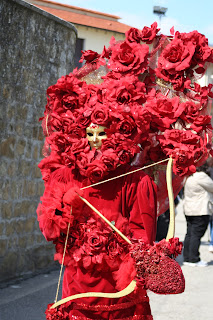Monteriggioni, from 5th to 7th and from 12th to 14th July2013
In these two weekends, Monteriggioni dresses up, comes to life real and legendary characters of a bygone era, but it still creates mystery and magic. Acrobats, jugglers, soldiers, ladies, knights ..... repopulate this ancient town, one of the most beautiful Italian villages, to make it even more fascinating and charming. Even outside the walls will set up a military garrison, with soldiers and horsemen, ready to leave for the Crusades in the Holy Land.The visitor participates in this atmosphere, in fact at the entrance of the castle you can change the Euro with the "Grosso", the ancient coin of the Sienese Republic, coined specially for the occasion. In addition, there are stalls and inns where you can taste typical local dishes, accompanied by an excellent wine.
The narrow streets and alleys come alive with ancient crafts, such as the blacksmith, the concai that reveal the secrets of the pitchers, farriers and shop the grocer, the baker.The program is full of events and initiatives, with music, medieval dances, street performers, theater performances that will leave visitors spellbound.Are also planned activities for children, such as making toys, clothing and medieval objets. In addition, children can play typical medieval games, including the game of tug of war, the game of the beam, rope and ball games as the oldest Alea and Poison.

Tickets
• Friday: 8 € - reduced 6 €
• Saturday: Adults 12 € - reduced 10 €
• Sunday: full 10 € - reduced € 8
Free for children up to 10 yearsHow to reach Monteriggioni:By car: And 'possible to reach from the highway Firenze-Siena Monteriggioni. Take the exit and follow the signs Monteriggioni.By train: The nearest train station to the castle of Monteriggioni, "Castellina in Chianti-Monteriggioni," Via Berrettini 1, fraz. Castellina Scalo (about 3 km from the castle).
By Bus: The local public transport service road is undertaken by the TRAIN of Siena. The main line that passes from the Castle of Monteriggioni is no. 130 A and R, which connects Siena and S. Gimignano. No bus to the castle. There are three different stops around the hill of the village, called Schools Monteriggioni, Monteriggioni Monteriggioni City and Rotunda. From each you need to walk up to the castle walking distance (300-400 meters).
For info and schedules: http://www.trainspa.it
Monteriggioni, 5-6-7 luglio 2013 e 12-13-14 luglio 2013
In questi due fine settimana, Monteriggioni si veste a festa, tornano a rivivere personaggi reali e leggendari di un passato ormai lontano, ma che suscitano ancora mistero e magia. Acrobati, saltimbanchi, giocolieri, soldati, dame, cavalieri.....ripopolano questo antico borgo, fra i più bei borghi italiani, per renderlo ancora più suggestivo ed affascinante. Addirittura fuori dalle mura verrà allestito un presidio militare, con soldati e cavalieri, pronti per partire per le Crociate in terra Santa.
 Il visitatore partecipa a questa atmosfera, infatti all'ingresso del castello si può cambiare l'Euro con il "Grosso", l'antica moneta della Repubblica Senese, coniata appositamente per l'occasione. All'interno, inoltre, sono presenti bancarelle e locande dove si possono degustare piatti tipici locali, accompagnati da un ottimo vino. Le stradine ed i vicoli si animano con antichi mestieri, come il fabbro, i concai, che svelano i segreti della lavorazione degli orci, i maniscalchi e la bottega dello speziale, il fornaio.
Il visitatore partecipa a questa atmosfera, infatti all'ingresso del castello si può cambiare l'Euro con il "Grosso", l'antica moneta della Repubblica Senese, coniata appositamente per l'occasione. All'interno, inoltre, sono presenti bancarelle e locande dove si possono degustare piatti tipici locali, accompagnati da un ottimo vino. Le stradine ed i vicoli si animano con antichi mestieri, come il fabbro, i concai, che svelano i segreti della lavorazione degli orci, i maniscalchi e la bottega dello speziale, il fornaio.Il programma è ricco di eventi ed iniziative, con musica, danze medioevali, artisti di strada, spettacoli teatrali, che lasceranno i visitatori ammaliati.
Sono in programma anche attività per i più piccoli, come la realizzazione di giocattoli, oggetti ed indumenti medioevali. Inoltre i bambini potranno giocare a giochi tipici medievali, come il gioco del tiro alla fune, il gioco della trave, palla a corda e giochi più antichi come Alea e Veleno.
Biglietti
- venerdì: intero 8 € – ridotto 6 €
- sabato: intero 12 € – ridotto 10 €
- domenica: intero 10 € – ridotto 8 €
Come raggiungere Monteriggioni:
In auto: E' possibile raggiungere Monteriggioni dalla
superstrada Firenze-Siena. Prendere l'uscita Monteriggioni e seguire le
indicazioni.
In treno : La stazione ferroviaria più
vicina al castello di Monteriggioni: "Castellina in
Chianti-Monteriggioni", Via Berrettini 1, fraz. di Castellina Scalo
(distanza dal castello 3 km circa).
Per info: http://www.trenitalia.com
Per info: http://www.trenitalia.com
In autobus: Il servizio di trasporto
pubblico locale su strada è effettuato dal TRAIN di Siena. La linea principale
che transita dal Castello di Monteriggioni è la n. 130 A e R, che collega Siena
con S. Gimignano. Nessun bus raggiunge il castello. Esistono tre diverse fermate
attorno alla collina del paese, denominate Monteriggioni Scuole, Monteriggioni
Comune e Monteriggioni Rotonda. Da ognuna occorre salire al castello a piedi
(distanza 300-400 metri circa).
Per info e orari: http://www.trainspa.it (formato .pdf).
Segui Tuscany in a nutshell su Google+
Per info e orari: http://www.trainspa.it (formato .pdf).


















